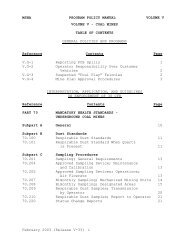MSHA HANDBOOK SERIES - PH13-V-1 - Mine Safety and Health ...
MSHA HANDBOOK SERIES - PH13-V-1 - Mine Safety and Health ...
MSHA HANDBOOK SERIES - PH13-V-1 - Mine Safety and Health ...
Create successful ePaper yourself
Turn your PDF publications into a flip-book with our unique Google optimized e-Paper software.
GENERAL COAL MINE INSPECTION PROCEDURES AND<br />
INSPECTION TRACKING SYSTEM <strong>HANDBOOK</strong> CHAPTER 4<br />
In the event of a mine accident where rescue <strong>and</strong> recovery work is necessary, Section<br />
103(j) of the Act grants the inspector broad authority to take whatever action,<br />
including the issuance of orders, that the representative deems appropriate to protect<br />
the life of any person. Where appropriate, the inspector may supervise <strong>and</strong> direct the<br />
rescue <strong>and</strong> recovery activity.<br />
Immediately on arrival at the mine accident scene, or later as mine rescue operations<br />
develop, the inspector may determine that direct control is necessary, either entirely or<br />
partially, particularly in situations where a less hazardous rescue procedure is<br />
desirable. Because of this broad authority, discretion <strong>and</strong> good judgment on the part<br />
of the inspector are imperative.<br />
Under Section 103(k) of the Act, the inspector can issue any such order as deemed<br />
appropriate to ensure the safety of any person, including a Section 107(a) order if an<br />
imminent danger is found. Again, it is important to emphasize that the inspector must<br />
exercise discretion <strong>and</strong> good judgment when issuing a 103(k) order. The following<br />
instructions are provided to assist in exercising this discretion:<br />
1. The Section 103(k) order is issued to ensure the safety of any person at the mine,<br />
<strong>and</strong> should apply to relevant areas of the mine to accomplish this. In some cases, the<br />
order will only apply to the accident site itself. In some accidents (for example, a<br />
fire, explosion, or inundation), the extent of the hazard may not immediately be<br />
known, <strong>and</strong> the order may apply to the entire underground mine until the extent of<br />
the hazard is clarified. Additionally, the inspector may apply the order to the entire<br />
underground portion of the mine if evidence reasonably indicates the same safety<br />
risks are present throughout the mine.<br />
2. The Section 103(k) order should remain in effect until a systematic evaluation of the<br />
conditions <strong>and</strong> safety practices is conducted, <strong>and</strong> <strong>MSHA</strong> reasonably determines that<br />
hazards similar to those that caused or contributed to the accident have been<br />
eliminated. The evaluation can be made prior to the accident investigation or<br />
concurrent with it. After this evaluation <strong>and</strong> determination have been made, the<br />
Section 103(k) order may be modified to permit an area of the mine to resume<br />
operations, or terminated if appropriate, provided that such action will not pose a<br />
hazard to the miners.<br />
3. In addition, Section 103(k) requires the operator to obtain the inspector’s approval of<br />
any plan to recover any person in a mine, to recover the mine, or to return affected<br />
areas of the mine to normal.<br />
Release 1 (February 2013) 4-26
















